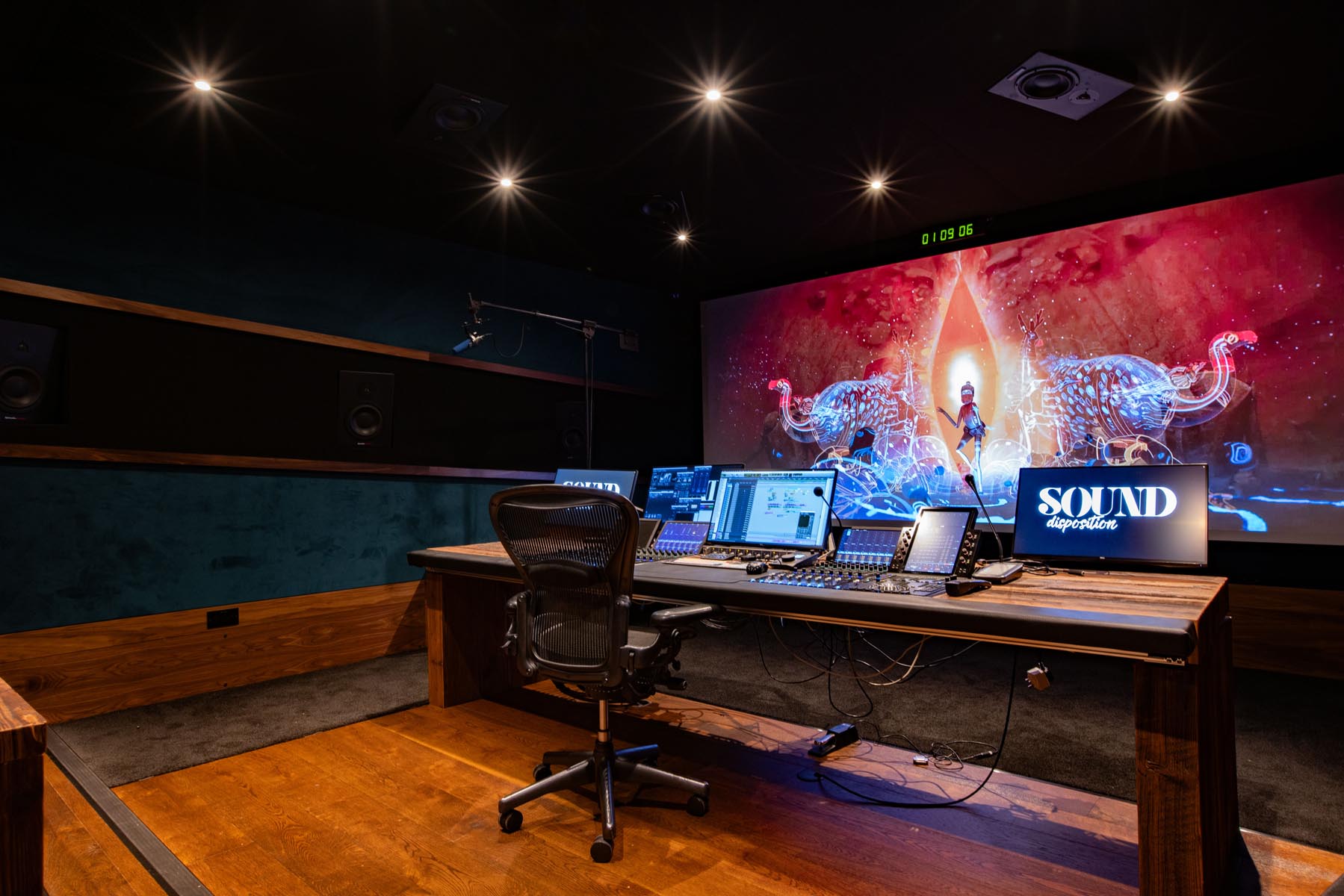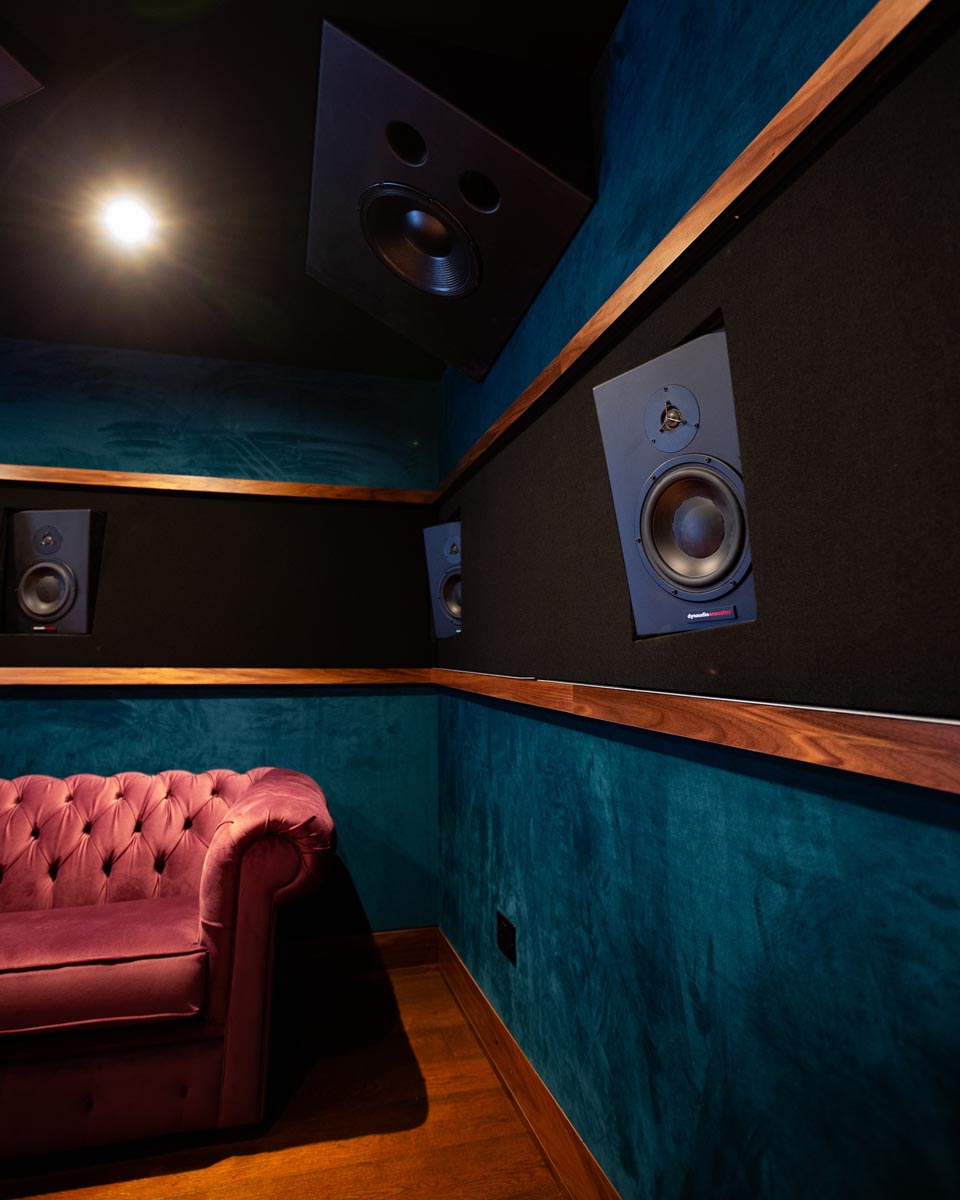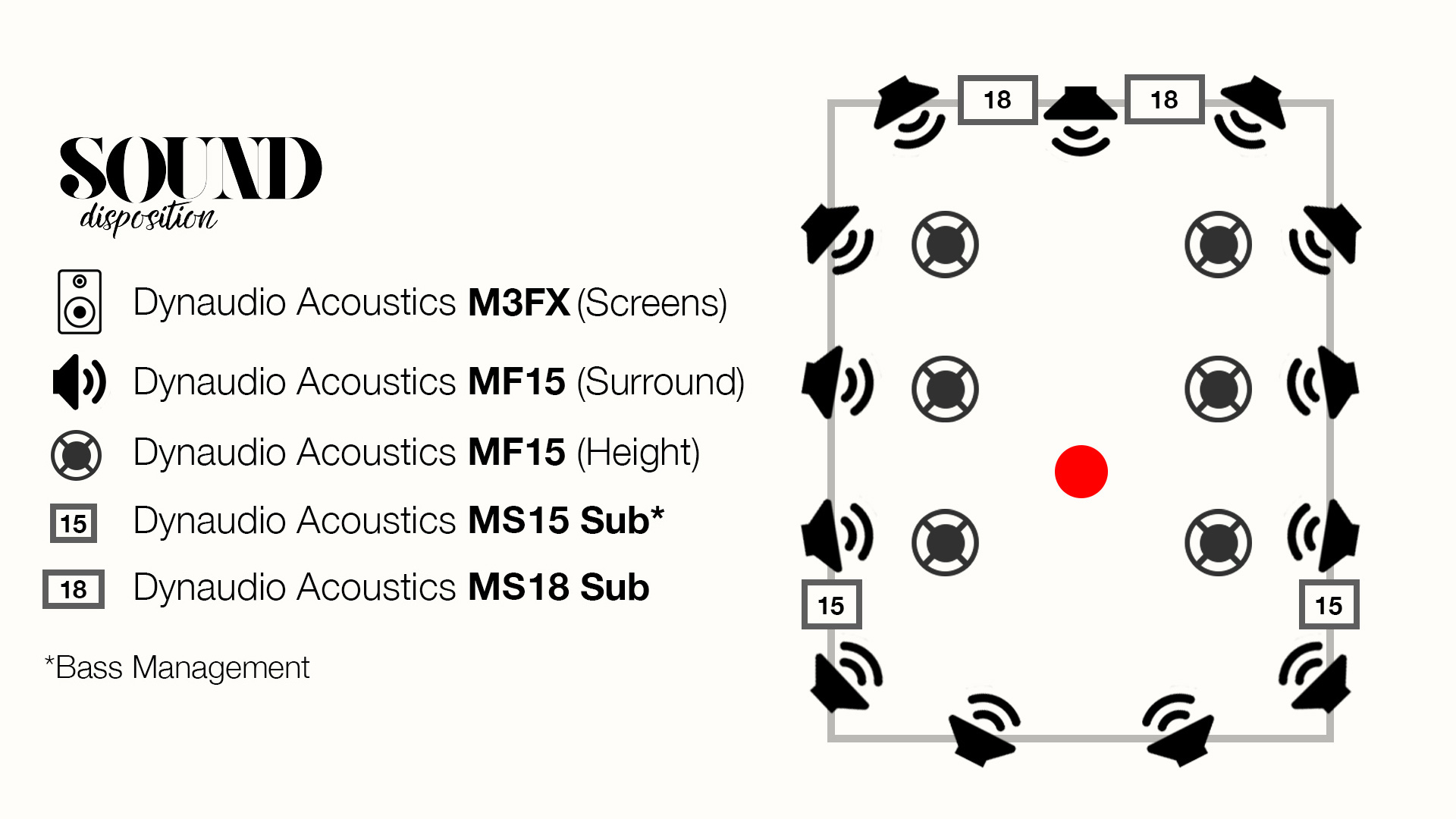
We head to Soho to check out the new Mix Stage at Sound Disposition, one of London’s premier audio post-production houses.
Sound Disposition has built an impressive and varied portfolio across film and television. The team has a long-standing creative partnership with director Nick Love, contributing to titles such as The Sweeney, American Hero and Marching Powder starring Danny Dyer.
They’ve also supported a wide range of independent features – including The Strangers trilogy, which became Lionsgate’s highest-grossing release of last year. An equally extensive list of television credits includes major series like A Town Called Malice and Bulletproof, and ADR contributions for globally acclaimed shows including The Sandman, Ted Lasso and Fallout.
We sat down with Re-recording Mixer and Sound Disposition’s head honcho Roland Heap for a chat about why he loves indie films; what the future holds for post-production; and how mixing at Abbey Road led him to choose Dynaudio M-Series monitors for the studio’s Dolby Atmos rig.
See more videos at Synthax TV
“Studio before beard”
“I don’t actually use any. I don’t like putting oil anywhere near my face,” Roland tells us in answer to our opening question – the important subject of beard oils. “I just don’t really like it. I know there’s a lot out there – I guess it’s a bit like running a studio, there’s basically always something you can spend money on haha. So no, not spending much on the beard right now, my life is very much about the studio. That’s fine, studio before beard.”
Sound Disposition begun life as a collaboration between founder Roland Heap and two fellow engineers back in 2008. What started as a simple framework to organise their freelance work has since evolved into one of London’s premier audio post-production facilities, home to a ten-strong team spanning a range of disciplines – from mixers and engineers, to Foley artists, sound recordists and dedicated admin staff.
“We’re a sound post production facility with two bases – one here in Fitzrovia on Great Titchfield Street, and another up in Tottenham,” Roland explains. “My primary role is as a Re-recording mixer – we’re a company very much comprised of enthusiasts. Everyone is extremely passionate about sound in general – how it can transform a piece of drama or a narrative. That’s always been very much at the core of everything we do.
“We’ve got a total of six studios spread across three floors. The room we’re in currently, which is our biggest mix stage; an ADR room; and another mix room downstairs. And then up on the first floor we’ve got a further three studios. Those are predominantly used for ADR recording, although they’re all multi-purpose rooms in one sense or another – we were recording ADR in here just yesterday in fact. So we can switch things around pretty quickly when we need to.”
A full-scale post-production house in the heart of Soho, the Sound Disposition studio was designed and built by Miloco, who are responsible for designing many of London’s top studios (including Composer Dominik Scherrer’s studio Shoreditch Recording Works, who we spoke to earlier in 2025).
“There were a number of people that made this build possible,” Roland says. “I’d definitely like to credit Miloco and the team there – Pete Hoffman and acoustician Nick Whitaker – both of whom did an amazing job in terms of their designs and supervision throughout the process, and helping us maximize the space. A really fantastic job by those guys.”

From Blockbusters to Boutique
Reflecting the breadth of their talented team, Sound Disposition embraces projects of all shapes and sizes – from small independent films to Hollywood blockbusters, as well as immersive installations and experimental sonic experiences.
“I’d say we’re probably unusual in a sense, because our work really is split across a whole number of very different areas,” Roland says. “We cover mixing, sound design, dialogue editing – but we’ve also got a fully specified Foley studio in Tottenham, who produce brilliant work and are constantly busy.
“Our core work is very much in feature films and TV Series, but we also do a lot of independents, as well as some work in advertising.
“And then also quite a lot of work in the immersive sphere, which is an area we’ve been getting into more and more recently. A range of projects for museums, as well as an immersive art experience in Marble Arch called Frameless. We did all the sound design for their permanent exhibition there, and also recently a project for National Portrait Gallery up in Manchester.
“I do love working on short films, everyone here does. Even though they very rarely provide any sort of meaningful monetary benefit,” he laughs.
“It’s just a brilliant way of discovering new film-making talent in general – actors, directors. There are probably some people we’ve worked with for over 10 years before they bring a project with us that has any meaningful budget, so it’s a long game. But that’s the nice thing – I mean I like to think we’re driven as much as possible by creative intent – and we’ll always try and find time for smaller filmmakers. If they come through the door with a great idea that they’re passionate about, and that excites us as well, we’ll usually try and find a way to squeeze it into the schedule one way or another.
“And then we also have an equipment rental side of things, which has become a main supplier of microphones for most of the central London post facilities. That was originally born out of having this surplus of equipment left over from my location recording days. But it’s grown into something that stands very much on its own feet – with a fairly remarkable collection of miscellaneous and unusual microphones – that we rent out to all sorts of people.
“It’s great because when someone comes with an ADR session, we can furnish them with literally any microphone they want. Or if we’re working on a feature and we want to go and gather sound effects, we’re able to deploy virtually anything we want. Ultra rare hydrophones for capturing something underwater? We’ve got immediate access to that. So really everything feeds into this sense of a very versatile company, which is utterly dedicated to sound.”

Dynaudio M-Series
For its speaker system, Sound Disposition’s main Mix Stage uses cutting-edge monitors from Dynaudio Acoustics M-Series. We were interested to know what led Roland to specifying them for his studio.
“I’ve had the pleasure of working in a huge range of other people’s Mixing Theatres,” reflects Roland. “One of the most impressive rooms I’ve worked in in this capacity is the Abbey Road mix stage. I’ve probably mixed five or six features in there – it’s a really, really good room. Technically exceptional of course, coupled with the fantastic vibes and technical support of the studios. It’s got that precision in terms of the monitoring, and it gives you the absolute confidence that your mix is going to translate well, whether you’re playing it on a larger system or on a smaller system.
“These days you’re dealing with replay systems that will range from sound bars to very high-quality home setups, all the way through to cinemas. And then of course some of the other work we do – venturing into variable immersive setups and things like that – we wanted something that would be able to cater to all of that. So that’s where I discovered Dynaudio, because it’s the system that they’ve got at Abbey Road. It’s not flattering, but nor is it harsh or clinical. It’s a very, very well-balanced sound system in a very good sounding room.
“So when I knew it was a possibility we could put in a system of the same calibre for our own room, that was a very exciting prospect to me.”

The Sound Disposition rig comprises of the following speakers from Dynaudio’s high-end M-Series of passive studio monitors, designed for the most discerning of pro studios:
- 3 x Dynaudio Acoustics M3FX (screens)
- 10 x Dynaudio Acoustics MF15 (surrounds)
- 6 x Dynaudio Acoustics MF15 (height)
- 2 x Dynaudio Acoustics MS18 (subs)
- 2 x Dynaudio Acoustics MS15 (bass management)
Together these components deliver exceptional clarity, low-end precision and superb spatial imaging – ensuring accurate translation across theatrical, broadcast and streaming formats.
“The system we’ve got essentially involves three screen channels, all of which are full range,” Roland explains. We’ve got two subwoofers behind the screen, as well as front subs. And then in the room we’ve got a total of 16 channels, which are arranged essentially in four rows of four. So four along each wall, and four of the top two at the back.
“I think 13.4.6 is probably the closest as a configuration I would describe it as, but really it depends on how you decide to map it out. We can address most of the speakers natively within the Pro Tools panner, but we also have mappings for Spat (FLUX:: Immersive’s spatial audio engine) for when we’re doing our immersive work.
“It’s just got what I want from a monitor”
“And obviously it works with the Dolby renderer as well, so it allows us a really great amount of flexibility between all of those different reproduction methods, along with things like Ambisonics etc.
“It’s just got what I want from a monitor,” Roland says on the question of ‘why Dynaudio?’
“It’s got the ability to hone in on sound, but without sounding harsh and clinical like some speaker brands I’ve tried. For me they’re the speaker manufacturer that gives the best balance in terms of sound, one that will translate easily from one space – and one size of space – to another. They’re crisp, they’re ‘real-sounding’, they’re not flattering, they’re not overly clinical. It’s just a very good, well-rounded, sensible, flexible high-fidelity reproduction system, which is exactly what we need.”

Advice and the future
Roland was candid when asked what advice he’d give to aspiring filmmakers and sound designers. He described the industry as notoriously difficult to break into, and reliant on low or unpaid work that’s generally unsustainable without financial support.
“It’s a very tricky industry to get into,” Roland says. “There’s often a huge amount of nepotism, and a real expectation at the lower rungs that you need to be able to work for nothing, whilst at the same time being able to live in London — which is virtually impossible unless you’ve got incredibly wealthy parents.”
He’s equally critical of the traditional runner system, calling it “a relic from when tapes were being shuttled around Soho.” Today he says it mostly involves “making coffees for people and, if you’re lucky, getting to sit in the back of a room and peer over people’s shoulders. Which I don’t think is a particularly effective way to learn the ropes anyway.”
Instead, Sound Disposition runs internship and placement schemes through universities, offering students a more meaningful entry point. “Several of the people we’ve brought in on placements have ended up coming back and working for us,” he says.
For Roland, the goal is to find people with “a real interest in all aspects of sound” – from music and location recording to sound art – who are “flexible, creative and able to adapt.” He sums it up: “The traditional system is very broken, so this has been our solution to finding roles for people and a route into the industry.”
To finish off, we asked Roland what his thoughts are on the future of post-production, and what kind of changes he’s seen during his time. No surprises that in Roland’s opinion, the spectre of AI looms large.
 “I don’t think there’s ever been a time where there wasn’t extensive change happening for one reason or another,” Roland says of his time in the industry. “When I started at Abbey Road, every session was almost entirely tape. By the time I left, virtually everything we did was Pro Tools. That has continued to develop, going from 8-track systems through to 16-track.
“I don’t think there’s ever been a time where there wasn’t extensive change happening for one reason or another,” Roland says of his time in the industry. “When I started at Abbey Road, every session was almost entirely tape. By the time I left, virtually everything we did was Pro Tools. That has continued to develop, going from 8-track systems through to 16-track.
“And now you’ve got hundreds of track count systems, which are all used on a regular basis. Obviously, Pro Tools has still been still very much the dominant force within the industry, but there are now good competing systems out there. It’ll be interesting to see if any of them can ever unseat Pro Tools.
“At the moment, the major shift that everyone’s seeing is the development of AI, and what that’s going to bring. I’m circumspect about it – I think it is going to bring a lot of change – and in many ways I think it will be very destructive for a lot of work that people are doing. I think that it needs to be better regulated.
“But the flip side is also what it provides in terms of an additional suite of tools, which allow us to do things creatively that we couldn’t have done as easily before, if at all. So I think with sensible regulation it’s something that can be a net benefit, but that needs to happen sooner rather than later. Because otherwise it does risk being a destroyer of creativity rather than an enabler.”
Our thanks to Roland Heap and Sound Disposition. To find out about their latest work visit the website at www.sounddisposition.com
For Sound Disposition’s rental department, visit soundrentals.co.uk
See the full range of Dynaudio PRO Studio Monitors

![]()
Dynaudio is world-famous for making hand-crafted high-end loudspeakers for living rooms, home cinemas, cars and professional recording studios.
Since the beginning in 1977, the company has made iconic products rooted in a love of music and film – reproducing exactly what the artist intended. Nothing more, nothing less.





















